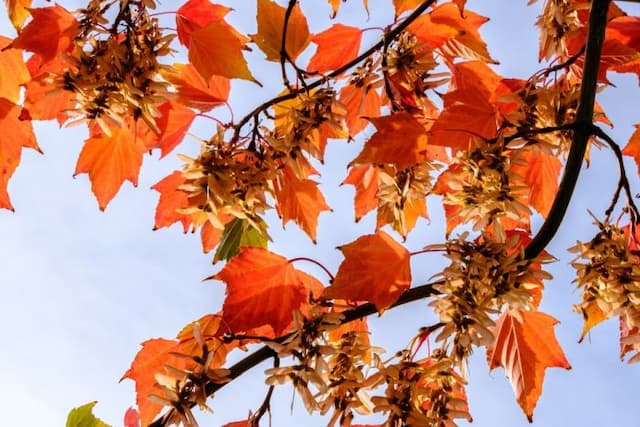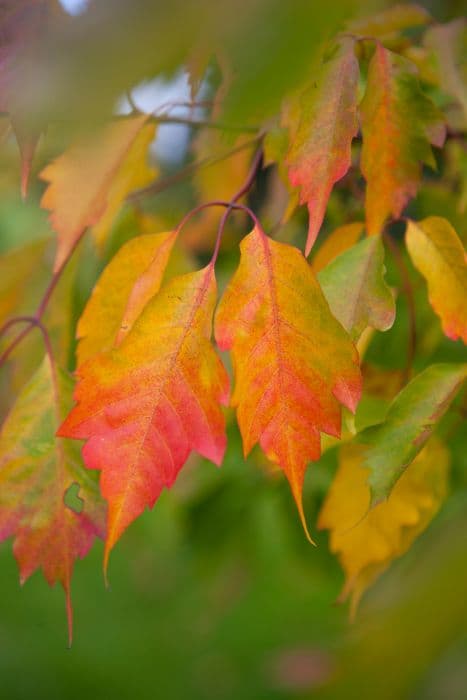Cappadocian Maple Acer cappadocicum

ABOUT
The plant commonly known as Cappadocian maple has a round and spreading canopy with a broad, spreading crown. Its bark tends to be smooth and gray when the tree is young, becoming slightly furrowed as it matures. The tree’s leaves are notable for their shape, which resembles a hand with extended fingers (palmate). They typically have five lobes and appear bright green, turning to rich shades of yellow or orange in the fall, which adds quite a bit of visual interest to the landscape. The flowers of the Cappadocian maple are small, yellowish-green, and hang in attractive clusters. They bloom in spring and are followed by the production of winged seeds known as samaras. These seeds are paired and spread out almost horizontally to each other resembling a pair of open wings that spin as they fall to the ground, helping with wind dispersal.
About this plant
 Names
NamesFamily
Sapindaceae.
Synonyms
Cappadocian Maple, Coliseum Maple.
Common names
Acer cappadocicum var. sinicum, Acer laetum, Acer lobelii Ten. non Mill., Acer lobelii var. cappadocicum, Acer pseudocappadocium, Acer trautvetteri, Acer velutinum non Boiss.
 Toxicity
ToxicityTo humans
The Acer cappadocicum, commonly known as Cappadocian maple, is not typically known for its toxicity to humans. There are no widespread reports of severe toxic reactions in humans from ingesting or contacting parts of this plant.
To pets
Similar to its effects on humans, the Cappadocian maple (Acer cappadocicum) does not have a known toxicity to pets such as dogs and cats. It is generally considered non-toxic, and there are no common symptoms associated with poisoning from this plant in pets. However, ingestion of any non-food plant material may cause mild stomach upset in some pets.
 Characteristics
CharacteristicsLife cycle
Perennials
Foliage type
Deciduous
Color of leaves
Green
Flower color
Yellow
Height
65 feet (20 meters)
Spread
50 feet (15 meters)
Plant type
Tree
Hardiness zones
5
Native area
Asia
Benefits
 General Benefits
General Benefits- Shade Provider: Acer cappadocicum, commonly known as Cappadocian maple, grows into a large deciduous tree that offers ample shade during hot summer months.
- Aesthetic Appeal: Cappadocian maple is known for its attractive foliage that changes color throughout the seasons, offering visual interest in landscape designs.
- Habitat for Wildlife: The tree provides habitat and food for various species of birds and insects, supporting local biodiversity.
- Erosion Control: The robust root system of the Cappadocian maple helps stabilize soil and prevent erosion.
- Timber Production: Wood from the Cappadocian maple can be used in the production of furniture and other wooden items due to its durability and workability.
 Medical Properties
Medical Properties- This plant is not used for medical purposes.
 Air-purifying Qualities
Air-purifying QualitiesThis plant is not specifically known for air purifying qualities.
 Other Uses
Other Uses- The wood of the Cappadocian maple is often used in the creation of musical instruments due to its resonant qualities.
- In woodworking, the fine grain of the Cappadocian maple's wood makes it a preferred choice for intricate carving and detailed cabinetry work.
- The wood can be used in veneer production for furniture and paneling, providing a decorative finish with its interesting patterns.
- Cappadocian maple trees can be tapped for sap, which can be used in the production of syrup, similar to other maple species.
- Dried wood from the Cappadocian maple is valued as high-quality firewood that burns slowly with consistent heat.
- The tree's fallen leaves can be collected and used as mulch in gardens to improve soil health and suppress weeds.
- Young branches and twigs could be woven into small handcrafted items such as baskets or decorative ornaments.
- The seeds, colloquially known as 'helicopters' due to their shape, can be used as a teaching tool to explain principles of aerodynamics to students.
- In landscape design, the Cappadocian maple is planted as an ornamental tree for its brilliant fall foliage that enhances aesthetic beauty.
- Leaf extracts from the Cappadocian maple might be employed as natural dyes in textile industries, though less common than other dyestuffs.
Interesting Facts
 Feng Shui
Feng ShuiThe Cappadocian maple is not used in Feng Shui practice.
 Zodiac Sign Compitability
Zodiac Sign CompitabilityThe Cappadocian maple is not used in astrology practice.
 Plant Symbolism
Plant Symbolism- Strength and Endurance: Acer cappadocicum, commonly known as Cappadocian Maple, is associated with strength due to its hardwood and endurance because the tree can live for many years.
- Adaptability: Its ability to thrive in various soil types and climates makes it symbolize adaptability.
- Growth and Renewal: As a deciduous tree that sheds its leaves annually, the Cappadocian Maple is often seen as a symbol of growth and renewal.
- Beauty and Grace: With its attractive foliage and graceful shape, this maple species represents beauty and grace in the natural world.
 Water
WaterThe Cappadocian Maple should be watered deeply once a week, allowing the soil to dry out slightly between waterings to prevent root rot. During the growing season in spring and summer, the tree may require more frequent watering, such as every 5 to 7 days, especially if the weather is particularly hot or dry. It's important to provide the tree with approximately 1.5 to 2 gallons of water at each irrigation, ensuring that the water penetrates deeply into the soil. During the fall and as the tree prepares for dormancy in winter, reduce watering to every 2 weeks or less, depending on the soil moisture and local weather conditions.
 Light
LightThe Cappadocian Maple thrives best in full sun to partial shade conditions. Ideally, it should be planted in a spot where it can receive at least 4 to 6 hours of direct sunlight each day. However, the tree can also tolerate light shade, especially in the hotter parts of the day or in regions with more intense sunlight. Areas that provide morning sun with afternoon shade are often ideal to protect the leaves from scorching in summer.
 Temperature
TemperatureThe Cappadocian Maple can withstand a wide range of temperatures, but it prefers a temperate climate. This tree can survive minimum winter temperatures down to around -20 degrees Fahrenheit and can handle maximum summer temperatures of about 90 degrees Fahrenheit. The ideal temperature range for promoting healthy growth is between 60 and 80 degrees Fahrenheit.
 Pruning
PruningPruning the Cappadocian Maple should be done to remove any dead or damaged branches, improve the tree's shape, and enhance air circulation within the canopy. It's best to prune during the dormant season, typically in late winter or early spring before new growth starts. The tree may be pruned every 2 to 3 years or as needed to remove any crossed or rubbing branches to maintain the tree's structural integrity and aesthetic appearance.
 Cleaning
CleaningAs needed
 Soil
SoilCappadocian maple prefers a well-draining soil blend with a mix of loam, peat, and sand in equal parts. The ideal soil pH for Cappadocian maple is mildly acidic to neutral, around 5.5 to 7.5.
 Repotting
RepottingCappadocian maples, being slow-growing trees, don't need frequent repotting. Young plants should be repotted every 2-3 years, while mature specimens may only require repotting every 4-5 years.
 Humidity & Misting
Humidity & MistingCappadocian maple thrives in moderate humidity levels typical of outdoor environments. It is not highly demanding in terms of specific humidity conditions as long as it is not excessively dry.
 Suitable locations
Suitable locationsIndoor
Provide bright light, avoid dry heat, and ensure good air circulation.
Outdoor
Plant in part shade, shelter from strong winds, mulch the base.
Hardiness zone
5-7 USDA.
 Life cycle
Life cycleThe life cycle of Acer cappadocicum, commonly known as the Cappadocian maple, begins with seed dispersal, which occurs in autumn when the samaras (winged seeds) separate and are blown by wind. Upon finding a suitable location with moist soil, the seeds germinate in spring, typically requiring a period of cold stratification to break dormancy. The seedlings then grow into juvenile plants, establishing a root system and a stem, with leaves unfurling to begin photosynthesis. As the plant matures, it passes through a vegetative stage where it increases in height and girth, forming a characteristic broad crown with ample foliage. After reaching maturity, which can take several years, the Cappadocian maple becomes reproductively active, developing small yellow-green flowers in spring that are pollinated by the wind. Having reached full maturity, it enters a cyclical phase of annual reproduction, producing new seeds each year while continuing to grow and potentially live for over a century if conditions are favorable.
 Propogation
PropogationPropogation time
Early spring
The Acer cappadocicum, commonly known as Cappadocian maple, is typically propagated using its seeds. The most popular method for propagating this tree involves collecting the seeds in the fall after they have matured. Once collected, the seeds can be sown immediately or stored and stratified to overcome dormancy; this involves mixing the seeds with moist sand or peat moss and keeping them in a refrigerator at about 34 to 41 degrees Fahrenheit (1 to 5 degrees Celsius) for approximately 60-90 days. After stratification, the seeds are sown in the spring in a well-drained soil mix, covering them with a thin layer of soil. It is crucial to keep the soil moist but not waterlogged to promote germination. Seedlings usually appear in a few weeks and can be transplanted when they are large enough to handle.









